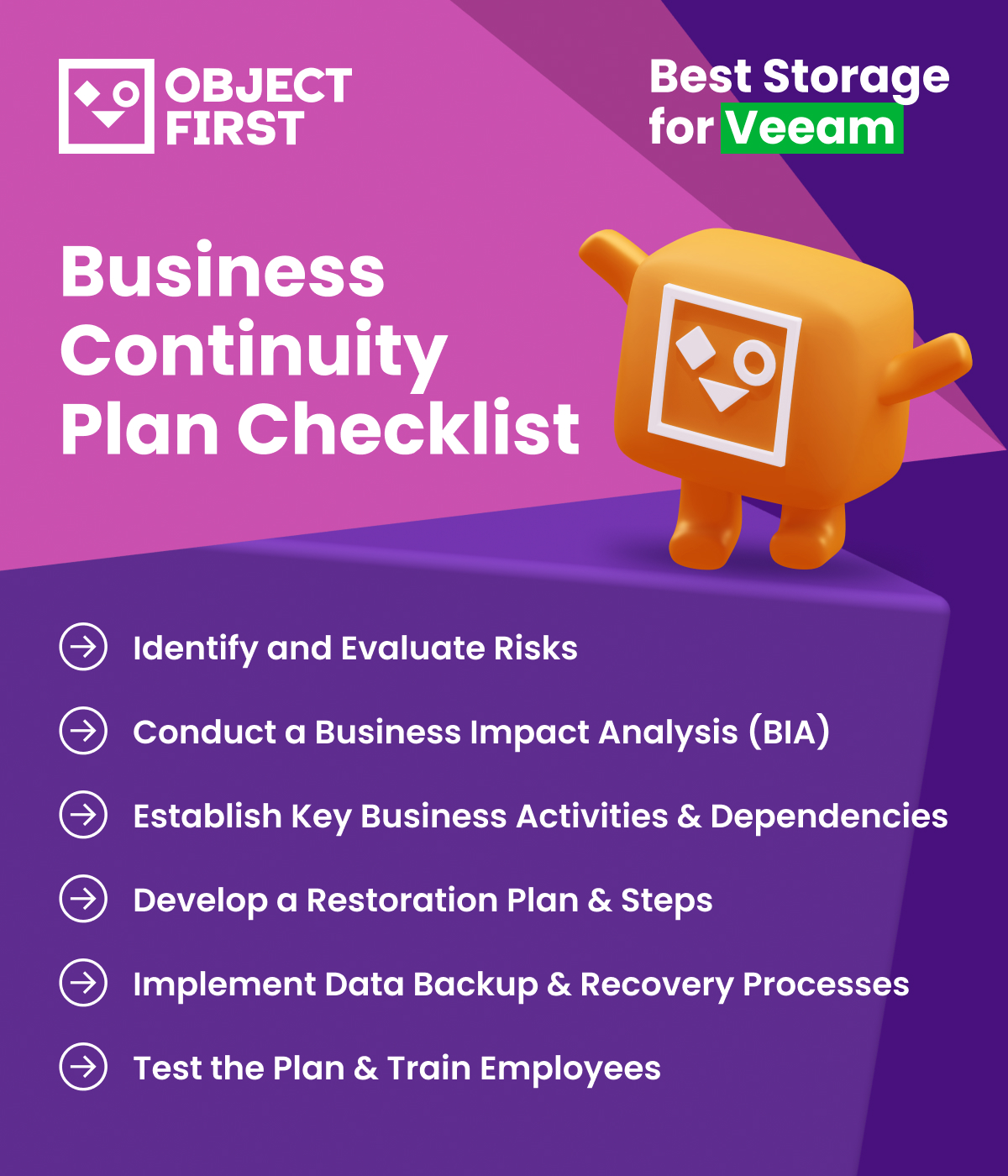Business Continuity Plan (BCP): A Step-by-Step Guide
Imagine your business brought to a halt by an IT outage, costing you $5,600 per minute. The chaos is overwhelming, the losses are mounting, and your team scrambles to find a solution.
A Business Continuity Plan (BCP) is your lifeline, ensuring your organization can swiftly recover and keep operations running smoothly.
Learn everything about BCP to protect your data and stay resilient in the face of disruptions.
Key Takeaways
- How to create a robust Business Continuity Plan (BCP) that addresses potential threats, minimizes downtime, and ensures smooth recovery from disruptions.
- The distinct roles of Business Continuity Plans and Disaster Recovery Plans and how to ensure your organization is well-prepared for both operational and IT-related incidents.
- Why are immutable backups crucial for protecting data from cyber threats and other crises, and how do they fit into a comprehensive BCP strategy?
What Is a Business Continuity Plan (BCP)
A Business Continuity Plan (BCP) is a system designed to ensure that an organization can continue its critical operations during and after a disruption.
This comprehensive plan outlines procedures and instructions that help businesses prepare for, respond to, and recover from unexpected events such as natural disasters, cyber-attacks, and other crises.
Why Having a Business Continuity Plan Is a Must
Companies face numerous threats that can disrupt operations and hurt profitability.
With the average ransom demand reaching $4,321,880 and 63% of demands being for $1M or more, it's clear that the stakes are high.
Here's why having a BCP is indispensable for minimizing the impact of costly threats.
- Minimize Downtime: A BCP helps maintain operations, reducing operational downtime and ensuring continuous service delivery.
- Protect Financial Health: By preventing prolonged disruptions, a BCP safeguards your revenue streams and reduces the financial impact of unexpected events.
- Enhance Data Security: A well-designed BCP includes measures to protect against data loss and cyber-attacks, boosting data security.
- Safeguard Reputation: Maintaining business operations during a crisis shields your brand's reputation and fosters customer trust and loyalty.
- Regulatory Compliance: Many industries require compliance with specific regulations regarding business continuity, and a BCP guarantees you meet these standards.
- Employee Safety and Morale: A BCP includes plans to defend employees, ensure their safety, and boost morale during emergencies.
- Customer Confidence: Demonstrating preparedness and the ability to uphold services during disruptions increases customer confidence and retention.
- Competitive Advantage: Companies with robust BCPs can quickly adapt to changes and recover faster than competitors, gaining a strategic edge in the market.
7 Steps to Create a Business Continuity Plan
Creating a robust Business Continuity Plan (BCP) ensures your organization can effectively respond to disruptions.
It includes the following steps:
Step One: Conduct a Business Impact Analysis
Identify and evaluate the functions and resources paramount for your operations. Determine the impact of potential crises on these functions.
Step Two: Identify Potential Risks and Threats
Assess internal and external risks that could affect your company, such as natural disasters, cyberattacks, and supply chain disruptions.
Step Three: Develop Recovery Strategies
Create detailed plans for recovering critical functions and processes. Outline specific actions and resources needed to mitigate risks and ensure continuity.
Step Four: Form a Continuity Team
Assemble a team responsible for developing, implementing, and managing the BCP. Assign roles and responsibilities to guarantee everyone knows their part in the plan.
Step Five: Create a Communication Plan
Establish clear communication protocols for internal and external stakeholders. Ensure all employees, customers, and partners are informed during a disruption.
Step Six: Implement Training and Testing
Train your continuity team and employees on the BCP. Conduct regular drills and simulations to test the plan and identify any weaknesses or gaps.
Step Seven: Review and Update Regularly
Review and update the BCP regularly to reflect changes in your business environment and operations. Make sure that the plan remains practical and up-to-date.
Comprehensive Business Continuity Plan Checklist
According to the Federal Emergency Management Agency (FEMA), 40% of enterprises never reopen after a disaster and another 25% fail within a year.
A well-prepared Business Continuity Plan (BCP) checklist helps you respond to and recover from unexpected events, systematically addressing and mitigating risks.
It consists of the following elements:
Risk Identification and Evaluation
- List all potential risks and hazards.
- Evaluate the likelihood and impact of each risk.
- Prioritize risks based on severity and probability.
Business Impact Analysis (BIA)
- Assess financial and operational impacts, including lost sales and increased expenses.
- Prioritize business functions based on their criticality.
- Determine recovery priorities and strategies.
Key Business Activities & Dependencies
- Identify essential functions for business continuity.
- Document dependencies such as key personnel and communication flow.
- Prioritize functions to ensure seamless operations.
Restoration Plan & Steps
- Define recovery phases, from disaster declaration to normal operations.
- Establish clear steps for each phase.
- Assign roles and responsibilities for recovery.
Data Backup & Recovery Process
- Develop a strategy for data backup and recovery.
- Convert physical documents to digital formats where possible.
- Outline procedures for quick and effective data recovery.
Plan Testing & Employee Training
- Conduct regular drills and simulations.
- Train employees on their roles within the BCP.
- Review and update the plan based on test results and feedback.

Business Continuity Plan vs. Disaster Recovery Plan
Business Continuity Plans (BCPs) and Disaster Recovery Plans (DRPs) are fundamental to organizational resilience but focus on different aspects.
With 96% of global IT decision-makers experiencing at least one outage in the past three years, it's crucial to understand the distinct purposes of BCPs and DRPs for managing and recovering from various incidents.
Here’s a comparison to highlight their distinct purposes:
|
Aspect |
Business Continuity Plan (BCP) |
Disaster Recovery Plan (DRP) |
| Objective | Ensures business operations continue smoothly during any hiccups. | Focuses on getting IT systems and data back online after an incident. |
| Focus Area | Keeps the whole business running and minimizes overall losses. | Reduces IT downtime and recovers tech infrastructure. |
| Key Components | Develops strategies for ongoing operations, trains staff, and builds resilience. | Details IT recovery steps, data backups, and critical application restoration. |
| Personnel Involved | Engages staff from multiple departments. | Mainly involves IT teams. |
| Example | Keeping customer service and supply chains active during a natural disaster. | Restoring systems after a ransomware attack. |
Ootbi – Your Vital Component of a BCP
With cyberattacks targeting backup data in 93% of cases, immutable backups are a must-have for any robust Business Continuity Plan (BCP).
They provide tamper-resistant data copies, ensuring your data remains secure and you can quickly recover from an attack.
Built on cutting-edge immutable object storage technology, Object First's Ootbi (out-of-the-box immutability) is ransomware-proof, delivering secure, simple, and powerful backup storage for Veeam customers.
Request a demo and witness how Ootbi can protect your business from cyber threats, disasters, and accidental deletion.
FAQ
What Are the Benefits of a Business Continuity Plan?
A business continuity plan ensures that your organization can maintain operations during disruptions, minimizing downtime and financial losses. It also helps protect your company's reputation, boosts customer confidence, and assures regulatory compliance.
What Are the Critical Elements of a BCP?
Key elements of a business continuity plan include conducting a business impact analysis, identifying potential risks and threats, developing ransomware recovery strategies, forming a continuity team, and establishing a communication plan. Regular training, testing, and updating of the plan are also essential to ensure its effectiveness.
How Often Should the Business Continuity Plan Be Updated?
A business continuity plan should be reviewed and updated at least annually or whenever significant changes in your business environment or operations occur. Regular updates ensure the plan remains relevant and effective in addressing new risks and challenges.
How Do Immutable Backups Enhance a BCP?
Immutable backups create tamper-proof copies of your data, protecting it from cyber threats, accidental deletion, and corruption. This guarantees that critical data can be quickly restored, allowing your business to recover swiftly from any disruption.



